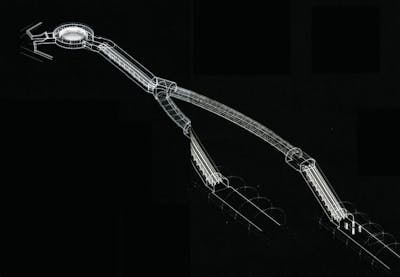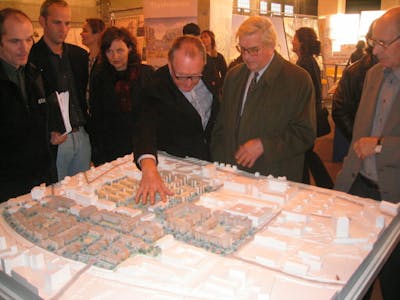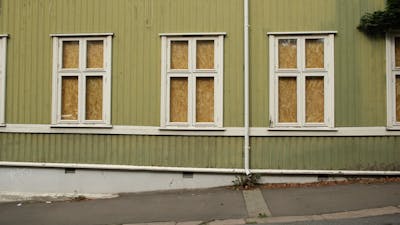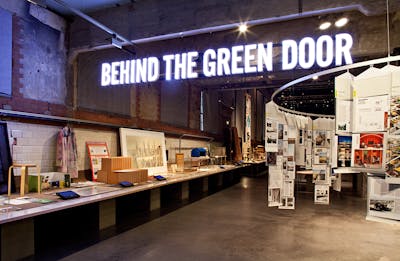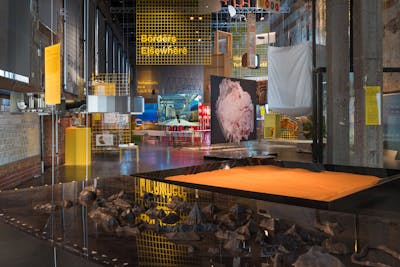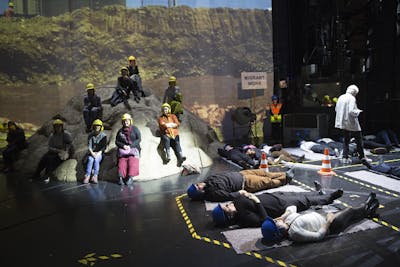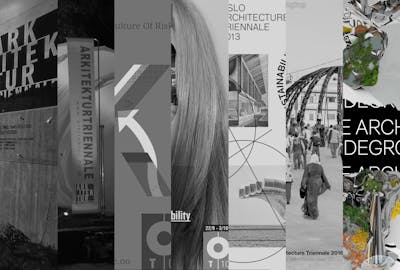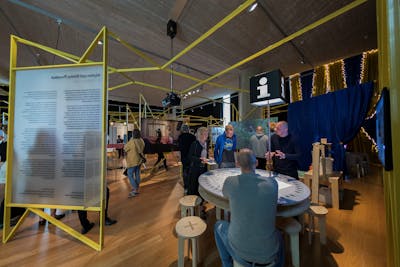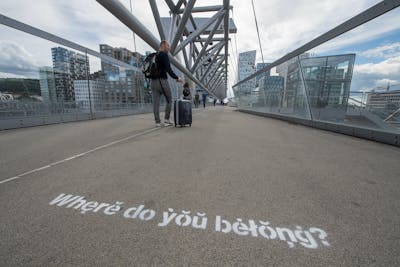ETTER TILHØRIGHET: OM Å KOMME TIL – OM Å KOMME FRA
Scroll down for English
I 2014 søkte After Belonging å utfordre formatet og målene til triennalen. Målet var å skifte fokus fra sluttprodukt til prosess, og slik revurdere arkitektens rolle i møte med samtidens utfordringer. I tillegg til to utstillinger og en bok, fasiliterte vi en internasjonal konferanse og etablerte et residency-program, der arkitekter kunne bo og engasjere seg i fem prosjektområder rundt om i verden. Vi fikk også bygd en midlertidig ambassade inne i Oslo Rådhus, og i samarbeid med AHO lanserte vi en ny undervisningsplattform. Formatene hadde sammenheng med utfordringene vi ønsket å diskutere: Hvordan arkitektur bidrar til å knytte oss til steder, i en sammenheng der global sirkulasjon er definerende for måten vi lever livene våre på.
Alle de seks plattformene – utstillinger, bok, konferansen, ambassaden, residency-programmet og akademiet – var like relevante for prosjektet, med sine egne ambisjoner og sitt eget publikum. For eksempel var ikke boken en tradisjonell utstillingskatalog, men et eksperimentelt verk i sin egen rett. Ikke bare for å skape et varig avtrykk som levde videre etter triennalen, men for å bruke bokformen for å diskutere spørsmål knyttet til romlig bestandighet, eiendom og identitet. Vi bestilte 20 essays fra ulike disipliner, geografiske sammenhenger og historiske utgangspunkt. Boken tilbyr dermed dybdelesning av nye tanker rundt tilhørighet, og den etablerer en dialog mellom tekstene og de 50 prosjektene som ble stilt ut på triennalens to utstillinger. Gjennom fem ulike felter dannes sammenhenger mellom de ulike stemmene som er inkludert i triennalen.
Et annet aspekt som bør trekkes frem vedrørende boken, er hvordan den inkluderte de 50 prosjektene fra utstillingen. De ble ikke fremstilt i samme form i boken som i utstillingslokalene. I stedet dokumenterte deltagerne prosess og metoder fra sine undersøkelser. Boken er en del av triennalens arv. Den kortlivede perioden til utstillingene og de andre arrangementene er ikke dermed sagt uviktige. På åpningen og avslutningen kom et internasjonalt publikum til Oslo for å bidra til en bredere diskusjon, der folk som normalt ikke snakker med hverandre ble bragt sammen – det er også en del av ettermælet. Utstillingene på sin side viste nytt materiale til et lokalt publikum, og førte til videre diskusjon og samtale.
Ulike publikum.
Rollen, ambisjonen og interessen til vertskapet er viktig for å
balansere ut forholdet mellom det lokale og det internasjonale. Vi ble
rekruttert for å kuratere triennalen gjennom en internasjonal åpen
utlysning. Både utlysningen og juryavgjørelsen understreket verdien av å
skape et prosjekt med relevans både i og utenfor Oslo, og vi var et
team som brakte et internasjonalt perspektiv til Norge. Målet var derfor
å dyrke frem en tematisk tilnærming med internasjonal appell og lokal
gjennomslagskraft.
I denne utviklingsprosessen, måtte vi justere våre egne perspektiver
som kuratorer fra ulike byer, på samme måte som vi tok innover oss den
lokale virkeligheten. Dette var ikke bare enkelt, siden «et lokalt
publikum» ikke er en homogen masse. Tvert imot var det en rekke ulike
publikumsgrupper vi ønsket å adressere gjennom triennalen, både lokalt
og internasjonalt. Vår rolle som utenforstående var særlig viktig gitt
at tematikken var nettopp tilhørighet. Vi ønsket å anspore en
refleksjon rundt hvordan vi bygger nye kollektive former utenfor den
tradisjonelle ideen om hvordan folk er rotfestet i sine egne miljøer.
Triennalens publikum bestod av en blanding av internasjonale
besøkende (særlig fra vestlige land) nordiske borgere, og først og
fremst folk fra Oslo. Dette var praktiserende arkitekter, forskere,
studenter og en generell offentlighet. Triennalen ble som sagt
strukturert via ulike formater, henvendt til ulike publikum. Vi så for
eksempel for oss at publikasjonen skulle henvende seg til et akademisk
publikum, med håp om at triennalens tematikk skulle inkluderes i kurs på
arkitekthøyskolene – i Oslo og andre steder. Akademiet inviterte
arkitektstudenter fra så vel Oslo og Bergen som Venezia, Hong Kong og
London. Utstillingene In Residence og On Residence henvendte seg hovedsakelig til arkitekter og akademikere, så vel som et bredt publikum.
Arkitektonisk praksis.
En del triennaler og biennaler er først og fremst en statusrapport fra
samtiden. Vi fokuserte på et spesifikt tema og ville vise frem arbeidene
til folk som allerede arbeidet med tematikken vi tok opp. Men vi ønsket
også å åpne samtaler med ulike aktører som kunne produsere nye
arbeider, og vi bestilte verk som var spesifikke for triennalen. Vi
snakket for eksempel med Ila Bêka og Louise Lemoine fra Living
Architectures om å lage en film som reflekterte den tilhørigheten som
oppstår i en Airbnb-leilighet. De endte opp med å filme Selling Dreams,
som ble et fantastisk bidrag til triennalen, men som senere fikk et
videre liv gjennom andre utstillinger og festivaler, blant annet
Performa 17 i New York. Studio Folder gjorde på sin side et glimrende
arbeid knyttet til hvordan satellitter lager representasjoner av
planeten, et nytt steg i deres prosjekt for å undersøke skiftende
landegrenser.
En triennale har potensial til å bli en katalysator for enkelte
praksiser som ikke har noen naturlig tilhørighet i et ordinært,
kommersielt marked, men som allikevel konstituerer et tankegods som er
relevant for den arkitektoniske diskursen. For oss er triennalen en
viktig anledning til å løfte frem stemmene til alternative
arkitekturpraksiser. Den muliggjør ulike typer av tilknytning mellom
arkitektur og andre diskurser som befatter seg spesifikt med sosiale,
økonomiske og teknologiske samfunnsmekanismer. Vi tenker på en triennale
som et rom hvor nye arbeider kan presenteres, sirkuleres og diskuteres.
Drømmescenarioet er en plattform der profesjonelle, akademikere, andre
aktører og det brede publikum danner nye allianser, samarbeidsformer og
fundamenter for fremtidig arbeid. I åpningskonferansen kunne vi for
eksempel ta del i samtalen mellom Yameen Lari og Per Heggenes. Selv om
de begge arbeider med å skaffe boligløsninger til samfunn som er ødelagt
av væpnede konflikter eller naturkatastrofer, er tilnærmingen deres
høyst ulik. Lari arbeider med ad hoc-strategier i forlengelse av lokal,
bærekraftig byggeskikk, mens Heggenes gjennom IKEA-foundation utvikler
standardiserte, midlertidige konstruksjoner. Triennalen bringer disse
ulike stemmene sammen. Til syvende og sist håper vi at den
tidsavgrensede hendelsen en triennale er, kan sette et varig avtrykk på
Oslo som by og arkitekturen som disiplin.
Denne teksten er
basert på en samtale mellom Léa-Catherine Szacka og kuratorene i april
2018 i New York, under forberedelsene til Szacka’s bok Biennials/Triennials: Conversations on the Geography of Itinerant Display. Boken ble publisert av Columbia Books on Architecture and the City i 2019.
AFTER BELONGING: IN RESIDENCE, ON RESIDENCE AND THE WAYS WE STAY IN TRANSIT
Text by:
Lluís Alexandre Casanovas Blanco, Ignacio G. Galán,
Carlos Mínguez Carrasco, Alejandra Navarrete Llopis and Marina Otero Verzier
In 2014, After Belonging proposed to challenge the goals and formats of triennale events. The goal of this challenge was to focus on the process rather than the end product of the event and use it to rethink the different roles that architects could play to address present challenges. In addition to two exhibitions, the book, and the international conference, After Belonging implemented an in-residence program for architects to intervene in five sites around the globe, commissioned a temporary embassy to be built within the premises of the Oslo City Hall, and, in collaboration with the Oslo School of Architecture and Design, launched a new educational platform. The formats selected were connected with the concerns we were attempting to discuss: the ways in which architecture mediates our attachment to places and collectivities in the context of contemporary global regimes of circulation.
All six platforms—the exhibition On Residence, the exhibition and program In Residence, the After Belonging book, the international conference, The Embassy, and The Academy—were equally relevant for the project, each with its own ambitions, time, and audience. For example, we proposed the book not as the catalog of the exhibition but as an independent and parallel space of experimentation. It was not only about making the event of the Triennale last in the form of a physical object, but also about understanding the book as an opportunity to discuss and connect questions around spatial permanence, property, and identity in a different way. We commissioned twenty essays to expand on these ideas from different disciplines, geographical contexts, and historical moments. The book provides in-depth readings of new notions of belonging and establishes a dialogue between them and the fifty projects and interventions from both exhibitions of the Triennale. Through five different areas, it is a space of transversal connections of the voices included in the Triennale.
Another aspect to highlight about the book is the way we included the fifty projects and interventions of the exhibitions. They were not featured in the book with the format that they were presented in the galleries. Instead, the participants documented the processes and methodologies of their research. It is interesting to see the dialogue between those pieces based on the research process with the voices of the twenty experts. The book is part of the legacy of the Triennale. The ephemerality of the opening and the closing days, and of the whole period in which the exhibitions were open is defintely relevant as well. On the opening and closing days, there was a global community coming to Oslo, producing broader discussions, bringing together people who are normally not connected—and that is also part of the legacy. And the exhibitions brought local audiences in front of new materials. Although their presence in the city is ephemeral, they lead to new knowledge and future conversations in the city.
Diverse Audiences. The role, ambition, and interests of the host institution are important in leveraging the local and global orientation of the triennale. We were selected to curate the Oslo Architecture Triennale through an international competition. Both the open call brief as well as the jury decision supported the idea of selecting a project with relevance both in and outside of Oslo, and a curatorial team that could bring an international perspective and audience to the Norwegian context. In that sense, we shared with them the responsibility of developing the triennale around a topic that had a contemporary international relevance and simultaneously a local impact.
In that development, we had to negotiate our perspective as curators coming from different cities, the local reality we encountered during the two years of preparation, and the period in which the Triennale was open. It was not an easy question, as there are many aspects that define the local audience. In fact, there are many audiences, both local and global, that we had in mind when thinking about the agency that the triennale could have. Our role as outsiders was particularly significant given that the topic we were addressing particularly concerned questions of attachment and belonging. We wanted to trigger a reflection on how we might build new forms of collectivity beyond conventional forms of rootedness. So the difference between local and global audiences has a different value in relation to these questions.
The different audiences of the Triennale included a mix of an international audience (fundamentally coming from Western countries), the Nordic region, and Oslo in particular. It included practicing architects, researchers, students, and the general public. The Triennale was structured in different formats to speak towards those different audiences. For example, we imagined the publication to be addressed to academic audiences, with the hope of including some of the discussions of the triennale in the syllabi of university courses—in Oslo and abroad. The Academy invited schools of architecture coming from Oslo or from closer cities like Bergen, but also from distant ones like Venice, Hong Kong, or London. The audience here was mainly students, so their ideas and voices could be present in the conversation. The exhibitions In Residence and On Residence spoke mainly to architects, practitioners and thinkers, and for the general audience, both local and international.
Architectural Practices. Some architectural events act fundamentally as a scan of contemporary practice and try to document the state of the art. We focused on a very specific topic and sought to showcase the work of people who were already working on related concerns in order to advance architecture along what we considered a series of challenges characteristic of our time, both in the discipline and beyond. But we also wanted to open conversations with different agents that could produce new work and we commissioned pieces that were specific to the Triennale. For example, we talked to Ila Bêka and Louise Lemoine from Living Architectures about the idea of making a film reflecting on the forms of attachment established in an Airbnb apartment. They ended up filming Selling Dreams, a wonderful piece that was presented in After Belonging. But after Oslo, the film was then presented in many exhibitions and festivals internationally, including being part of Performa 17 in New York, for example. Studio Folder also did a great piece on satellite representations of the planet, which constituted another step in their research about moving borders.
A triennial has the potential to become a catalyzer for certain practices whose work may not find its place in the construction market, but whose ideas are relevant to advance architectural discourse. For us, triennales are important spaces for giving voice to other ways of practicing architecture. They also allow to connect architecture practices with discourses that address contemporary social, economic, or technological transformations. We imagine the trienniale as a space in which new work can be presented, circulated, and discussed. In the best of the scenarios, it serves as a platform where professionals, scholars, and diverse agents and audiences craft alliances, collaborations, and support for future work. For example, at the conference held during the opening week in Oslo, we could engage in a conversation between Yasmeen Lari and Per Heggenes. Even though they are both working to provide housing responses to communities displaced by armed conflicts and natural disasters, their approach to the question is very different. Lari proposes ad hoc strategies connected to sustainable vernacular construction techniques and to the revitalization of craft skills; and Heggenes, through the IKEA Foundation, is developing a standardized and exportable temporary model. The Triennale bridges these different voices, strategies, and formats, providing a powerful space of discussion that could provide new tools for future interventions. Ultimately, our hope was that, in their ephemeral condition, the different formats of the triennale could have a lasting impact both in the city of Oslo and in the discipline of architecture, helping address some of the most relevant challenges we are facing today.
This text is based on an conversation by Léa-Catherine Szacka with the curators of the OAT 2016: After Belonging in April 2018 in New York, in preparation of Szacka’s book Biennials/Triennials: Conversations on the Geography of Itinerant Display. The book was published by Columbia Books on Architecture and the City in 2019.

